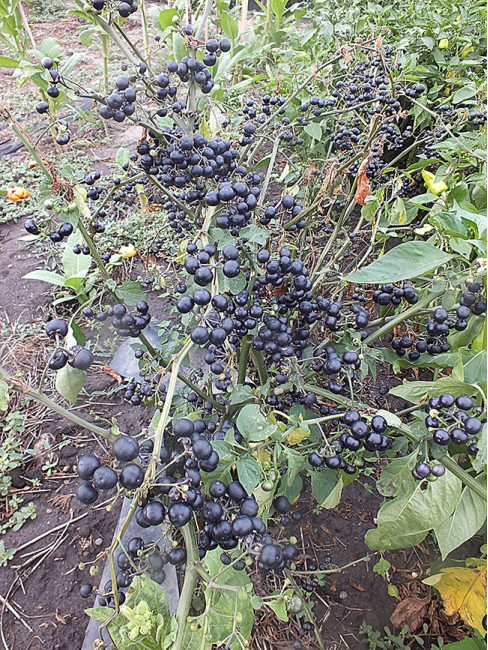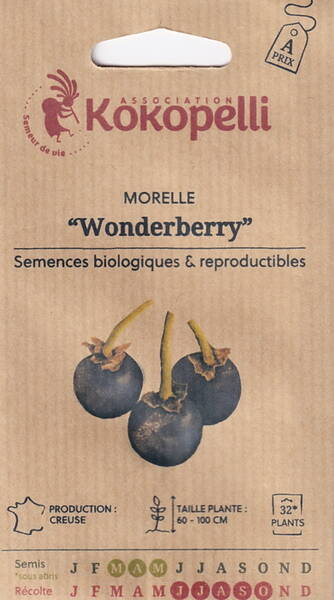Sunberry – a rare guest in our gardens and a real exclusive for lovers of unusual crops. It is a heavy-bearing nightshade plant with large, glossy black berries the size of a cherry, gathered in long clusters of 8–15 fruits. At ripening time the bush is literally covered with berries and looks truly ornamental, turning a bed or a corner by the greenhouse into a striking feature of the garden.
The variety was created by the great plant breeder Luther Burbank on the basis of interspecific crossing. From its African ancestor (Solanum guineense) sunberry inherited large fruits, high yield and unpretentiousness, and from the European nightshade (Solanum villosum) – a more pleasant taste. From one strong, highly branched plant you can harvest up to a bucketful of berries, and flowering and ripening continue until late autumn. The plant is cold-tolerant, withstands light frosts, is drought-resistant and is hardly affected by pests.
Sunberry berries have a neutral taste with a light nightshade note, therefore they are especially good for processing. They are used to make jam and jelly of an unusual dark colour, fragrant sauces for meat and cheese, thick fillings for pies and dumplings, compotes and homemade wine. Thanks to their strong colouring properties, the berries are ideal for adding intense colour to light preserves. Sunberry is valued for its high content of pectins, anthocyanins and other biologically active substances, and in folk tradition it is often called "wonderberry".

Advantages of sunberry:
-
large black berries in showy clusters;
-
high yield – up to a bucketful of berries per plant;
-
long fruiting period until frost;
-
decorative, vigorous bush 60–100 cm tall;
-
undemanding to soil and growing conditions;
-
versatile for processing – jams, compotes, sauces, fillings, homemade wines;
-
an original, little-known crop – a rarity for an ordinary vegetable garden.
Cultivation.
Sunberry is grown through seedlings using a technique similar to tomatoes. Sowing time under cover: March–May. Sow seeds in pots or trays at a temperature of +16…+20 °C under well-lit cover. Seedlings develop slowly, so it is important to provide light and moderate watering. After the true leaves appear, prick out the seedlings and then care for them as for tomato seedlings.
Plant out into the ground after the danger of late frosts has passed, burying the stem down to the first leaves. Planting scheme – about 70 × 80 cm, as sunberry bushes are strong and spreading. Choose a sunny or slightly shaded site with any garden soil (acidic soils are best limed). Water moderately, avoiding waterlogging. To support the heavy clusters of berries, it is recommended to install stakes or wires and tie up the side shoots so that the fruits do not lie on the ground.
Sunberry is undemanding, needs minimal care and only one or two feedings per season, yet it generously rewards attention with its beautiful appearance and stable harvest of unusual black berries, which will become a highlight of your garden and homemade preserves.

* Sunberry is a perennial from the nightshade family that is grown in our cool climate as an annual. It is a heavy-bearing plant with attractive black berries.
Other names: Canadian blueberry, garden nightshade, blueberry forte (it has nothing in common with our wild forest bilberry).
The plant is vigorous. The sunberry bush is strong, tall and very spreading. The stem is fairly sturdy, thick and ribbed, the side shoots are strong, and the leaves resemble those of nightshade. The plant is quite cold-tolerant and withstands slight frosts (down to -2 °C) without cover. Although sunberry belongs to the nightshade family, the Colorado beetle practically does not damage it.
The fruits are fleshy berries, first green and then black, the size of a cherry, gathered in clusters. Although the fruits do not have a bright taste or aroma, they are exceptionally useful. They are believed to slow down ageing of the body and help with neuroses, headaches and joint pain, angina pectoris, hypertension, gastritis, varicose veins, diabetes and many other conditions. They are used to make jams, preserves, sauces and even wine. The plant is drought and cold resistant and very easy to grow.
The berries are rich in alkaloids and have a general analgesic and sedative effect thanks to a mild narcotic influence on the medulla oblongata and spinal cord. They are also considered a diuretic and cleansing remedy.
This green giant is a truly unique sight when the berries ripen. The plant is completely covered with black berries the size of a large cherry. They are gathered in clusters of 10–15 fruits. The yield is up to a bucketful of berries per bush. Flowering and ripening continue continuously until late autumn. Fruit setting on the plant starts almost from ground level and continues up to the very top of the plant.
Sunberry is undemanding to soil and grows on all soil types, although acidic soils should be limed; it loves the sun.
The best predecessors for it are cucurbit crops grown on fresh manure.
Due to the long vegetation period, it is better to grow sunberry through seedlings. The technology of seed preparation and seedling cultivation is exactly the same as for tomatoes. However, the seeds germinate very slowly.
Sunberry can also be propagated by direct sowing into the ground, but in this case you may not get a harvest in our short summer. Sowing for seedlings should be done at the same time as for peppers.
To speed up swelling of the seeds, it is necessary to mechanically, without damaging the seed, break the integrity of the hard seed coat – lightly scarify the tough shell.
To do this, put the sunberry seeds into a jar with a tightly fitting lid, having first poured in washed and dried coarse river sand. Then shake the contents of the jar vigorously for a few minutes. Through the slightly damaged seed coat, water can easily penetrate and swelling will proceed much faster.
After the appearance of the first true leaf, prick out the seedlings and further care for them as for tomato seedlings, planting them out in open ground at the same time as tomatoes.
Plant sunberry seedlings sparsely, in rows, 70 cm apart and 80 cm between rows. The newly planted plants can be covered with a plastic bottle for 6–7 days until they take root. The planting of sunberry can be thickened with lettuce or onion for greens, which are harvested when the plants grow larger.
Care.
As the plant grows quickly, it needs support. The lateral shoots of sunberry spread to 90–100 cm, so they are best tied to stretched wire so that the berries do not touch the soil. During the growing season it is desirable to earth up the plants 1–2 times.
Unlike tomatoes, sunberry is not pinched (not pruned for side shoots). Only about 5 weeks before stable cold weather, new side shoots are pinched out every 2–3 days; this makes the remaining berries larger and allows them to ripen completely.
In general, the plant is very unpretentious and not demanding to soils. One feeding and infrequent watering are enough to obtain a very decent harvest of berries. When grown in a greenhouse, the yield is significantly higher than in open ground.
Harvest sunberry berries at the end of September, when they become black and firm. When harvested in clusters, they keep for a long time in a cool place without losing quality.
However, keep in mind that sunberry berries ripen very slowly and often do not have time to fully ripen before cold weather. But on the plant such berries hold tightly on the pedicel, and even when frozen they hang on the bush until the New Year and do not fall off.
For seeds, select the largest berries from the earliest and most fruitful clusters. In this way, year after year, the traits of earliness and productivity are fixed in the plants.
If desired, you can extend the consumption of fresh sunberry berries: in autumn dig up the plant, shake the soil off the roots and hang it upside down in a warm room.
Beneficial properties of the berries and their use.
In taste, sunberry berries are rather modest and resemble black nightshade, so before eating they should be scalded with boiling water and left to stand for a few minutes – then they become much tastier, and after October frosts the berries become sweeter. They can be eaten fresh, but you should not taste unripe berries, as they are very unpleasant.
With the addition of citric acid, the berries can be processed into jams and compotes, and with a small addition of sour fruits or berries, they make an excellent filling for pies and dumplings. Thanks to their colouring properties, sunberry berries can be added to light compotes to give them a wonderful colour.
To avoid a nightshade aftertaste in sunberry preserves, first scald the berries with boiling water, keep them in it for 2–3 minutes, drain the water and only then start processing.
The main value of sunberry berries lies in their healing properties: they contain many pectins that remove toxins from the body; selenium, which slows ageing processes; and anthocyanins, which improve the composition of the blood.
Thanks to their beneficial properties, sunberry berries are used to help with cramps, stomach spasms, bladder disorders, etc.
It is easy to prepare a "health elixir" from them.
To make it, dilute the freshly squeezed juice of the berries with water in equal parts. Then for 1 litre of diluted juice add 300 g of honey, bottle and store in the refrigerator.
Take 2 tablespoons before meals. This remedy is said to normalise blood pressure, relieve headaches, improve memory and visual acuity, increase stamina and the body's adaptive capacity to adverse factors.
It is no coincidence that in ancient times Hippocrates, Dioscorides and Avicenna successfully used nightshade to treat many illnesses: this is food that is medicine, and medicine that is food.
Sunberry leaves are also beneficial. They have strong antimicrobial activity, astringent and haemostatic effects, increase the acidity of gastric juice, relieve spasms of the smooth muscles of the intestines and urinary tract, and lower blood sugar levels, which is especially important for people with diabetes.
Many gardeners, seeing sunberry for the first time, reach for the bush and, asking what it is, pick a berry, put it in their mouth and immediately spit it out – the taste of fresh berries is not to everyone's liking, but everyone likes the wine. Pie fillings made from sunberry are also excellent. And sunberry jam has a unique flavour – a pleasant surprise for gourmets.












